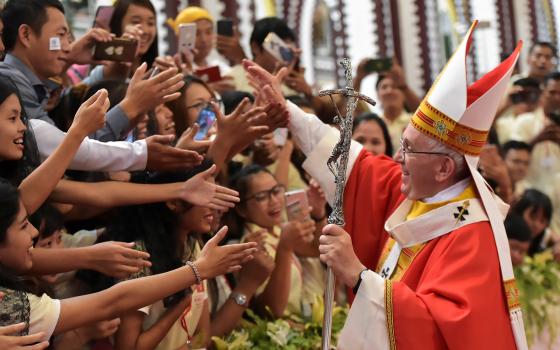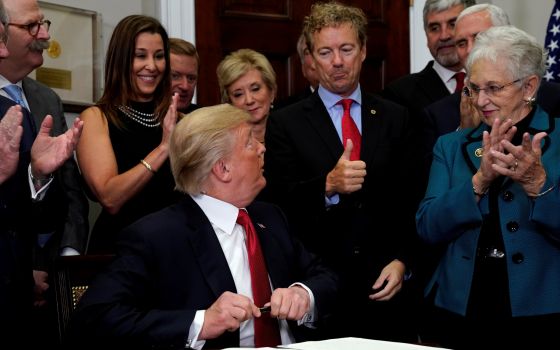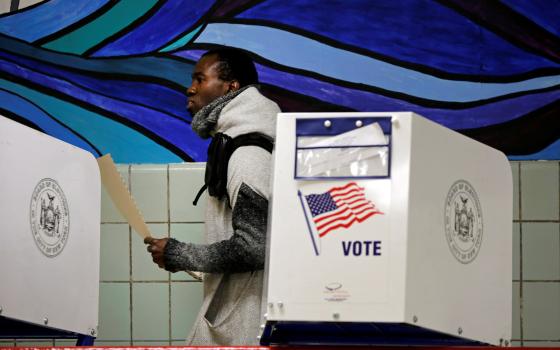
The steeple of St. Dominic Church in Washington is seen from the Museum of the Bible Nov. 15. (CNS/Tyler Orsburn)
What's coming for religion in the next 12 months?
RNS asked some of the country's top faith leaders, scholars and activists to predict what changes the religious landscape will see after the New Year.
From the Vatican to the Supreme Court, here's what they say we ought to keep an eye out for.
Margari Aziza Hill: A time of interfaith mass movement
Four years ago, I joined an email exchange that would begin the launch of Muslim Anti-Racism Collaborative (MuslimARC). I tweeted out to hundreds to join a hashtag conversation #BeingBlackAndMuslim during Black History Month and, together, we started a movement discussing race and faith. Since co-founding MuslimARC to address intersections of systemic racism, xenophobia, and Islamophobia, I have come to work closely with faith-based organizations such as IMAN, Bend the Arc and PICO. Leaders such as William Barber II, Rami Nashashibi, Stosh Cotler, Kameelah Mu’min Rashad and Valarie Kaur have been taking their liberation theology to the streets.
They are just a few examples of faith leaders who will continue to rise to the forefront in 2018. Importantly, 2018 will be a time when more people of faith will come together to build collective power. 2018 will be a year where interfaith work will be about recalibrating our nation’s moral and ethical social agenda.
2018 will be the year that churches, mosques, temples, synagogues, Gurdwaras and sacred spaces will work together to protect the most vulnerable. I see more people of faith coming together motivated to heal the divides and ugliness not just in their societies, but in their neighborhoods. 2018 will be the year that faith-based organizing will no longer be an aberration. I see faith leaders reaching across the aisle, pushing back against the nativism, xenophobia and partisanship. 2018 will be more investment in faith-based organizing, moving policies, healing on a city-wide, county-wide, state-wide and national level. City councils, state representatives, and government officials will get more calls and visits from people in congregations.
You’ll hear more about the wins from alternative media outlets and social media. So while the big media outlets won’t cover multi-faith movement making, movement is happening.
Margari Aziza Hill is the co-founder and co-director of Muslim Anti-Racism Collaborative (MuslimARC), a human rights education organization.
Rabbi Jeffrey Salkin: A Jewish #MeToo will lead to #PayMeRight
I predict the coming of #MeTooJew. I predict that accusations and stories of sexual harassment will embroil Jewish institutions, organizations, seminaries, and synagogues. Women—and, yes, men—will come forward with stories of abuse, reaching to the highest levels of Jewish communal leadership. I predict that we will see resignations of prominent Jewish communal executives.
I predict, further, that this new wave of accusations will prompt a larger conversation in the Jewish community — a conversation that we might hope will migrate into the larger culture. We need to discuss the blurred lines between sexual harassment, which has a legal definition, and men doing what men have been doing since, well, Adam. Men — and not only men — sometimes act like jerks. This is even and especially true in situations in which there has been no coercion, power plays, and sexual quid pro quos. Ultimately, the war against the yetzer ha-ra, the unholy inclination, is a failed war.
So, too, America needs a more expansive meditation on the meaning of confession and forgiveness. What does it mean for someone to confess their failings? What does it mean to do teshuva, or repentance? What is the statute of limitations for such failings? What are the ethical and communal implications of accusing those who are no longer alive and cannot defend themselves? Short of legal repercussions, what are the proper penalties for such moral failings?
I submit that Judaism has a rich textual tradition that could nourish such reflections.
Finally, the #MeTooJew movement will prompt Jewish women in executive positions, including the rabbinate, to start a new movement — #PayMeRight. They will be responding to the fact that Jewish women have been paid lower than their male peers who hold the same kinds of positions. I could even see, and welcome, protest demonstrations at the 2018 General Assembly, as well as at national meetings of every Jewish organization.
Advertisement
Because it is one thing for American Jewish leaders to bemoan the horrendous treatment of women at the Kotel in Jerusalem. Far better for us to change the behaviors towards women in the board rooms and executive suites of American Judaism.
Rabbi Jeffrey Salkin writes the award-winning column "Martini Judaism" at RNS. He also serves as the senior rabbi of Temple Solel in Hollywood, Fla.
The Rev. Gabriel Salguero: Kick-starting a new technicolor evangelicalism
In 2018, Latino evangelicals and other evangelicals of color will join younger evangelicals in moving U.S. evangelicals beyond partisan politics.
There will be a new technicolor evangelical manifestation that broadens U.S. evangelicalism's public engagement with a focus both on evangelism and the common good.
The Rev. Gabriel Salguero is president of the National Latino Evangelical Coalition and serves as a pastor at Calvario City Church, a large Assemblies of God congregation in Orlando, Fla.
Sr. Simone Campbell: Time to talk about race, poverty and justice
I predict that in 2018 race and poverty will be front and center in the national dialogue as faith leaders step out into the public square to issue a cry for justice. This cry will galvanize people around the country with the truth that poverty and racism are structural in our society and We the People can and will change that reality.
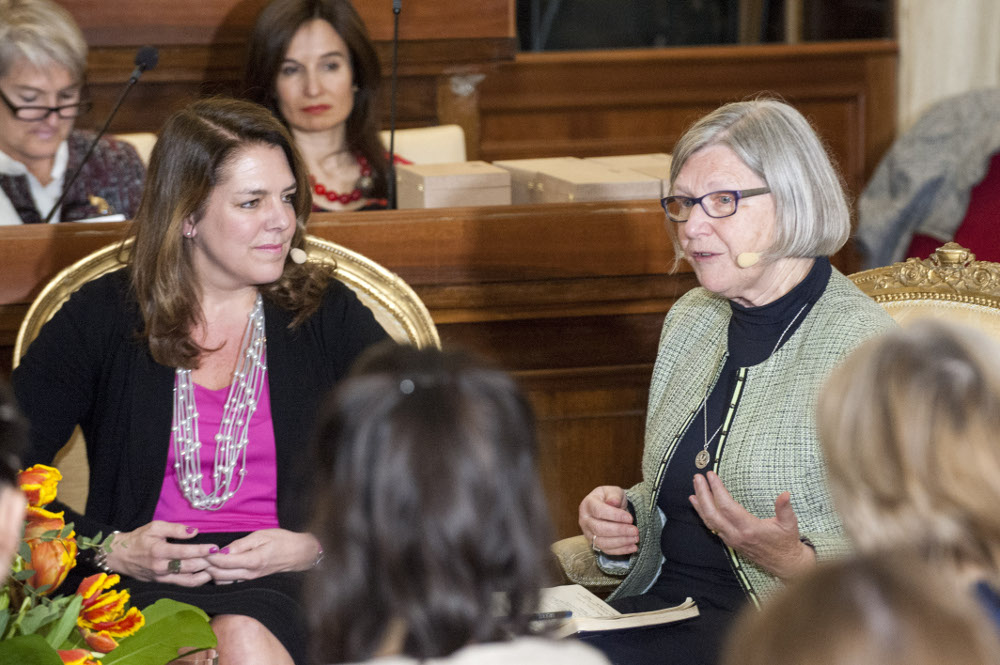
Kerry Alys Robinson and Sr. Simone Campbell, a Sister of Social Service, speak during the Voices of Faith gathering March 8 at the Vatican. The event, held on International Women's Day, had the theme "Stirring the Waters-Making the Impossible Possible." (CNS/Massimiliano Migliorato, Catholic Press Photo)
In the election cycle we will talk about the truth of 21st century poverty where families of our nation are poor because their wages are so low. We will talk about how food stamps and Medicaid go to working families because their employers neither pay enough in wages nor give benefits to their workers. In that conversation we will be able to shine a light on the policies passed by Congress that have created the racial wealth gap. These policies include redlining, the GI bill, student loans, and so many more. Once we recognize this structural racism, then we can make change happen.
Faith leaders will call out the lie of politicians who says that “we can’t afford the programs such as food stamps and Medicaid." We will demonstrate that these programs have become business subsidies to make up for the fact that our workers are not paid enough and therefore use programs to survive. We will call our nation to be its best self and to change the rhetoric … and the policy.
2018 will not change everything, but it will be a step towards publicly engaging the truth about race and poverty in the United States. Once raised to consciousness, we then will commit to change. This requires a step away from hyper-individualism and fear and toward community.
I’m not sure we have the courage to take this step, but I believe that 2018 will give us the clear choice. Once we talk about the truth of race and poverty in the U.S., will we be willing to commit to change? To answer yes, I believe that faith leaders will need to stand up and lead the way forward through a new wilderness on the way to healing and hope.
Sr. Simone Campbell is the executive director of NETWORK, a Catholic social justice lobby, and leader of NETWORK’s "Nuns on the Bus" movement.
Fr. Tom Reese: Catholics will loosen up on clerical celibacy
This is the year the Catholic Church will get serious about discussing the possibility of married priests.
The church has experienced a shortage of priests around the world, especially in developed countries. There are not enough priests to provide the sacraments, celebrate Mass or give pastoral care to the Catholic people.
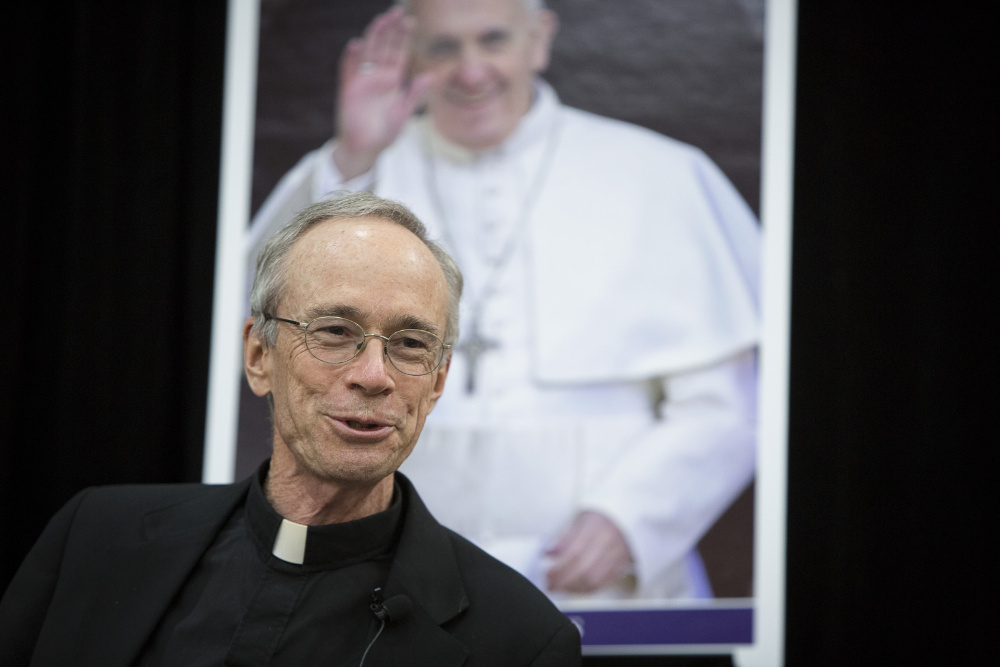
Jesuit Fr. Thomas Reese moderates a discussion on economic justice hosted by the Jesuits of Arizona and the Monsignor Edward J. Ryle Fund at Brophy College Preparatory in Phoenix Jan. 6. (CNS/Nancy Wiechec)
When asked by bishops for married priests, Pope Francis has told them to go back to their countries and get the bishops’ conference to request it and he will consider it. This year there will be a synod of bishops on youth and vocations, which will provide an opportunity to discuss optional celibacy. In 2019, there will be a synod for the Amazon, where bishops are desperate for priests. There is a good chance this synod will ask for married priests.
The celibacy requirement for Catholic priests is a matter of church law, not doctrine, and can be changed. In fact, for about the first 1,000 years of its existence the church had married priests. Eastern churches, like the Ukrainian Catholic Church, in union with Rome have a married clergy. Some Protestant ministers who have become Catholic have also been allowed to be ordained priests even though they were married. If change occurs, it will probably begin for areas of the world that request it, but it will then spread rapidly.
Fr. Thomas J. Reese, a Jesuit priest, is a senior analyst at RNS and writes its "Signs of the Times" column.
Patrick Hornbeck: Supreme Court will delay the inevitable in the 'cake case'
On Dec. 5, I attended the oral arguments in the Supreme Court case Masterpiece Cakeshop v. Colorado Civil Rights Commission. The first major LGBT rights case that the high court has taken up since Obergefell v. Hodges — the landmark 2015 ruling in favor of marriage equality — Masterpiece Cakeshop pits a Colorado baker, Jack Phillips, against the same-sex couple whose custom wedding cake he refused to make on religious grounds.
The lively and at times humorous oral arguments revealed a court predictably divided. The four typically progressive justices peppered Phillips’ attorneys with hypotheticals about what other kinds of discriminatory conduct might become permissible if the court ruled in the baker’s favor.
The conservative justices, on the other hand, expressed concern that a decision for the couple would compel Phillips, and by extension other business owners with strong religious convictions, to express points of view they find repugnant. Justice Anthony Kennedy, who has written the Court’s major gay rights decisions but also been its most ardent champion of free speech, unsurprisingly emerged as the deciding vote.
He worried about the dignity of LGBT people in the public square, but also roundly criticized Colorado officials who had disparaged Phillips’s beliefs at earlier stages of the litigation.
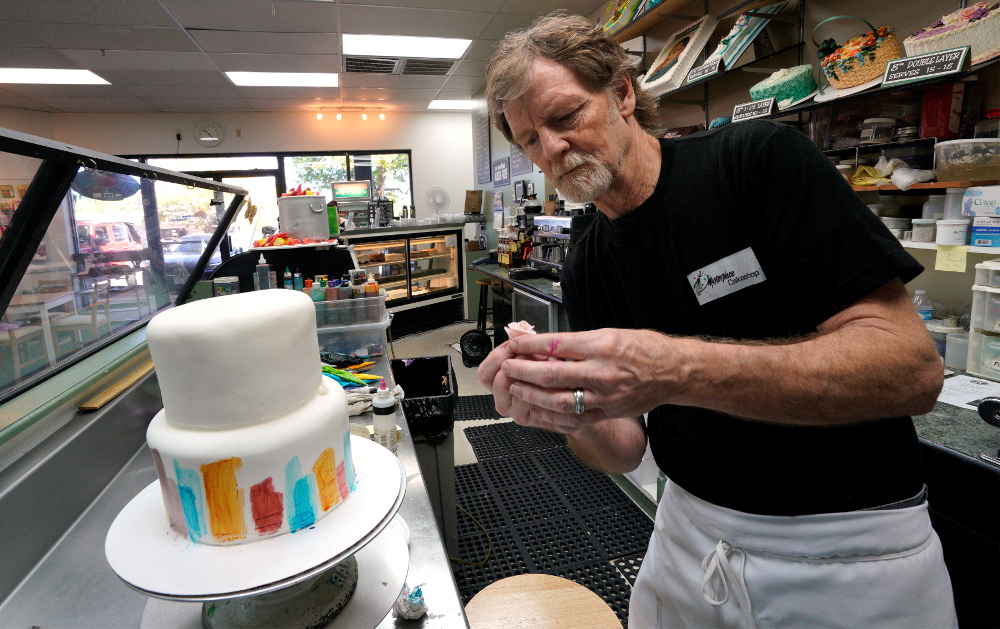
Baker Jack Phillips decorates a cake in his Masterpiece Cakeshop Sept. 21 in Lakewood, Colo. (CNS/Rick Wilking, Reuters)
A decision on the merits of the case would likely result in some of the harms that one or the other bloc of justices feared. A finding for Phillips would indeed confirm that businesses can use religious beliefs to shield them from anti-discrimination laws; a finding for the couple would indeed put religious business owners in the position of having to perform some services that they would rather not.
But here’s my prediction. There is another option available to the Court — hold that the Colorado officials’ animus toward Phillips’ conservative Christian views irreparably tainted the proceedings against him, and direct that the case be re-heard. The result would still almost certainly go against Phillips, and there would almost certainly be another round of appeals, but Phillips would be able to claim some vindication. And the court, which seems less than eager to press the logic of its decision in Obergefell and earlier cases to the conclusion that discrimination against LGBT people deserves heightened judicial scrutiny, could put that broader question off for another day.
Patrick Hornbeck is an associate professor of theology at Fordham University. He has been analyzing the Masterpiece Cakeshop case in a series at Religion Dispatches.
Asma Uddin: A new politicization in religious liberty
Religious liberty at its core is about live and let live. Flourish in your own religious expression and protect others’ right to do so, too — regardless of whether you agree with or even understand their religious practices.
From my vantage point as a decade-long religious liberty activist, this idea of live and let live was easy enough for some time. Yet, that is quickly changing. Even in the course of my still-young career, my religious liberty casework has gone from covering largely uncontroversial topics such as land use and prisoners’ rights to cases at the core of culture wars.
This shift reflects the state of religious liberty today — something no longer uncontroversial and largely unchallenged, but suddenly highly politicized. And in 2018, I expect this trajectory toward increased politicization to continue.
There are two strands of this phenomenon. On the one hand, the politicization is based on deep disagreements on questions of sexual morality. As Professor Doug Laycock explains, “On abortion, contraception, gay rights, and same-sex marriage, conservative religious leaders condemn as grave evils what many other Americans view as fundamental human rights.”
On the other hand, the divergence on religious liberty centers on Muslims and Islam. Specifically, many outspoken advocates of religious liberty find it perfectly consistent to simultaneously deny such protection to Muslims. Their reasoning is that Islam is not a religion (it’s apparently something else — such as a “political ideology”) and therefore doesn’t even qualify for religious liberty protections. The argument is bogus and alarming, but its increasingly salience in public discourse suggests that it may gain ground in 2018.
Asma T. Uddin is a fellow with the Initiative on Security and Religious Freedom at the UCLA Burkle Center for International Relations and Georgetown's Berkley Center for Religion, Peace, and World Affairs.
The Rev. David Gushee: A crossroads for white evangelicals
I predict that in 2018 some event involving President Donald Trump will pose a decisive moral test for his strongest base of supporters, white evangelicals.
Perhaps it will be new evidence related to sexual assault allegations against him, or an indictment from FBI Director Robert Mueller of his family members or even of the president, and a presidential firing of Mueller or pardon of the indicted.
Sadly, I think that we already know what will happen. A core of #Trumpvangelicals will remain loyal no matter what. They will take their talking points from Fox News. Their inability to offer anything resembling biblical moral reasons for their view will be painfully obvious. And it will be even more clear that whatever happens to Donald Trump will happen to these evangelicals, because they have become indistinguishable.
The Rev. David P. Gushee, who wrote the popular RNS column "Christians, Conflict & Change," is the director of Mercer University's Center for Theology & Public Life.
Max Perry Mueller: Mormons reach a tipping point on Trump
My 2018 prediction is that the Mormons break en masse from Trump and, to a larger extent, from the GOP.
As I, and others, have written before, the Mormons have never liked Trump. As the most famous Mormon anti-Trumper, Mitt Romney put it, Mormons generally view Trump as a “phony, a fraud.” Trump only got 14 percent of the Republican primary vote in Mormon-dominated Utah. And, for that brief window last October when a Trump presidency seemed impossible after the release of the Access Hollywood tape, Mormon politicians led the initial “all out revolt” against Trump’s candidacy.
Yes, 61 percent of Mormons nationally voted for Trump (the Mormons have long been the most reliably Republican voters of any religious group). And yes, Trump won Utah handily, though he only got 45 percent of the vote (Hillary Clinton and the conservative (and Mormon) independent candidate Evan McMullin combined for 49 percent). Finally, yes, Trump’s favorability rating in Utah — which has hovered around 50 percent — has outperformed other red states.
Nevertheless, there are several signs that the Mormon disdain for Trump has reached a tipping point.
First, there are Mormon (and Republican) politicians, like Arizona Jeff Flake, who are naming Trump for what he is: a threat to our democracy.
Second, while Trump was graciously received by LDS Church officials when he visited Utah early in the month, these same church leaders have consistently denounced Trump’s Islamophobic policies and rhetoric, and without explicitly naming the president, have called Trumpism’s “racism, sexism, and nationalism” bigoted and unchristian.
And third, there are everyday Mormons and other Utahns, many of who took to the streets of Salt Lake during Trump’s recent visit to protest the president in general, and his decision to shrink national monuments in Utah specifically.
Watch this last group. Not only are they souring on Trump, they are souring on the GOP. To be sure, the presence of the Mormon Evan McMullin on the ticket had a large impact, but starting with the 2016 election, the GOP share of the vote in Utah plummeted from 72.6 percent in 2012 to 45.9 percent in 2016. Just as the rest of the country is moving toward favoring the Democrats ahead of the 2018 midterms, so will Utahns.
For a significant number of Mormons whom I know, the election of the widely popular mayor of Provo, John Curtis, to replace Jason Chaffetz in the House has proven that, in the era of Trump there are no good Republicans — not even Republican Mormons.
Republican Curtis enjoyed the backing of some liberal Democrats who admired him as effective, integrity-filled public servant. But with a 100 percent pro-Trump voting record, Curtis has shown that anti-Trump Mormons can’t count on any Republican to check Trump. In 2018, Mormons in Utah might help turn the ruby red congressional districts in Utah blu(ish). Perhaps more importantly, the lasting effect for young Mormon voters coming of age in the Trump era could be a generational fissure between the GOP and their most loyal religious voting bloc.
It’s also worth it to note that Utah’s senior Senator Orrin Hatch’s strange love affair with Trump, rekindled after the tax vote this very week, might reinforce or nullify these predictions.
Max Perry Mueller is the author of "Race and the Making of the Mormon People" and an assistant professor at the University of Nebraska-Lincoln.
Diane Randall: A productive civil discourse will emerge, out of necessity
The testimonies of Quakers call us to live with integrity and simplicity and to work for peace and equality and to seek an earth restored. We want our lives to speak to the belief that there is that of God in every person.
2017 saw a wave of increased activism from millions of people across the country who made their voices heard at unprecedented levels. They showed up at congressional offices, town halls, sent emails, and jammed phone lines. People were moved to act by moral concerns and deeply held beliefs about the values and vision of what this country should be.
Faith communities came together in powerful ways to amplify the scriptural teachings that inform these critical questions about the common good, the role of government, how we treat each other and our earth — from welcoming immigrants and refugees, to assuring people have health care, to protecting the air we breathe and the water we drink. The commitment to economic and racial justice, human rights, diplomacy and peace are essential to Quakers. This aroused passion for social justice will grow in 2018.
We are at a moment in time when the power of prophetic witness is sorely needed. How will we love our neighbor without exceptions? From preventing war with North Korea to ending U.S. military support that fuels the humanitarian crisis in Yemen, we will speak out for peace and human rights. From pressing for permanent and just solutions for Dreamers to assuring the support of the federal government to assist struggling families pay for health care, housing and food on the table, we will advocate for people who are poor. The public is looking for leaders to articulate a direction for this country that is just and compassionate.
This means we will speak truth with love. In an atmosphere of anger and hateful rhetoric, we seek to fill the void of productive and civil discourse that people around the country are thirsting for. Our values and objectives remain the same regardless of who is in power or the political climate.
Diane Randall is the executive secretary of the Friends Committee on National Legislation.
Robert P. Jones: White evangelicals stay locked in for the GOP
2018 will likely see white evangelical Protestants remaining locked in for Republican candidates in the midterm elections. According to the exit polls, 81 percent of white evangelical Protestant voters pulled the lever for Donald Trump in the 2016 presidential election, and they strongly supported the president throughout his first year in office.
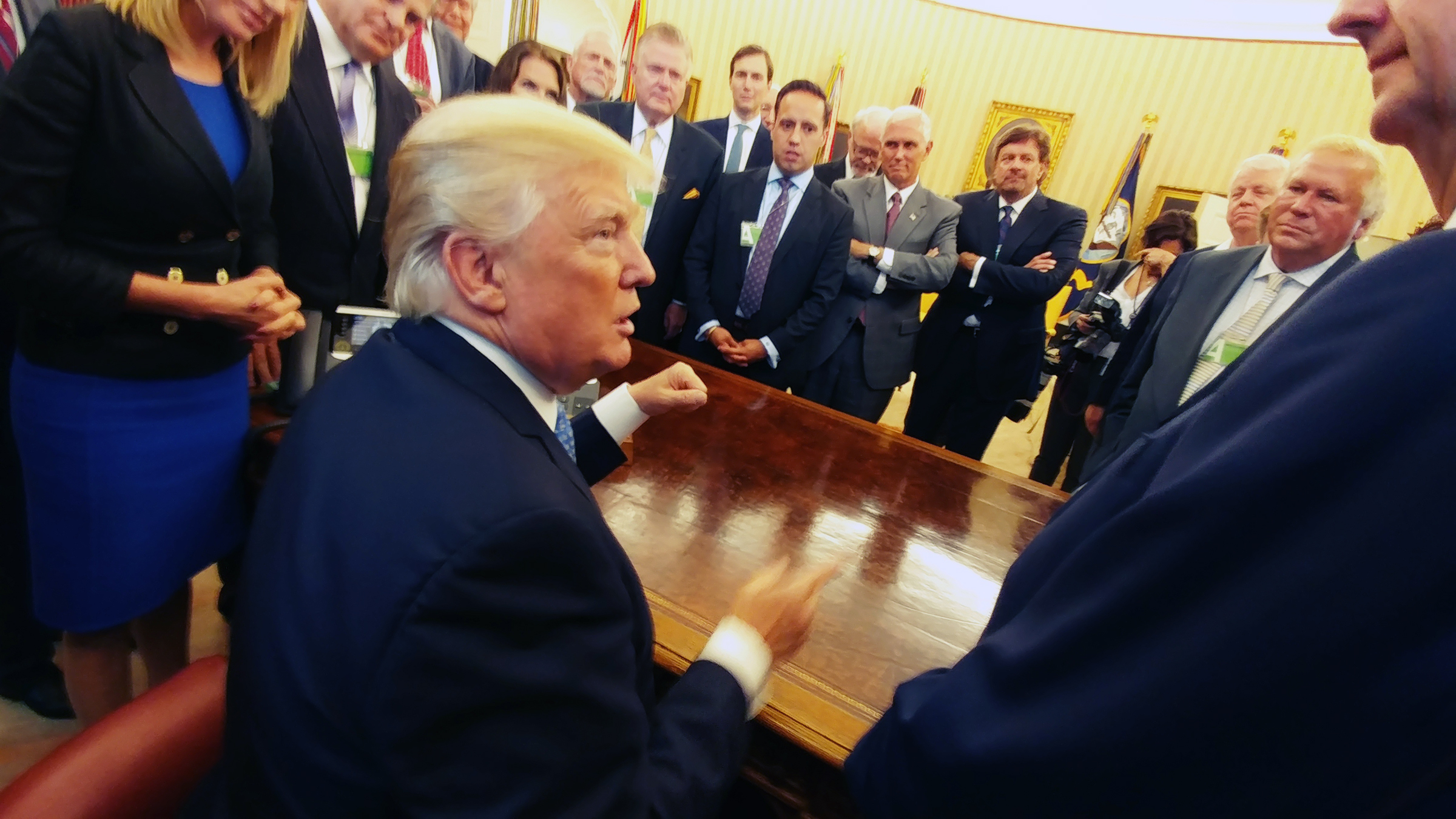
President Trump meets with faith leaders inside the Oval Office on July 10, 2017. (Mark Burns)
While Trump’s job approval rating among the general population hovered around 4 in 10 (and dipped occasionally into the 30s) for most of 2017, 72 percent of white evangelicals approved of his job performance in the fall, including 3 in 10 who said there was virtually nothing Trump could do to lose their support. In the Alabama special Senate election at the end of 2017, despite multiple allegations that Roy Moore had inappropriate sexual relationships with teenage girls, no major evangelical pastor in Alabama publicly spoke out against Moore, and white evangelical Protestants similarly rallied around him, with 80 percent voting for him over his Democratic opponent.
Simply put, in 2016 and 2017, white evangelical voters demonstrated that most have come to value partisanship and political goals over candidates’ character.
Even if the 2018 midterm elections turn out to be a wave election for Democrats, as the best barometers currently suggest, white evangelicals will likely remain tethered to tribal Republican loyalty, or at least to Democratic Party antipathy, no matter who is on the ballot.
Robert P. Jones is the CEO of the Public Religion Research Institute and author of "The End of White Christian America."
Jeanine Kraybill: Elevating female leadership in the Catholic Church
I believe 2018 will mark a period where we see Catholic female laity and women religious continue to be a strong collaborative leadership model, not only for the institutional Church, but on key social policy issues.
Female Catholics are leading parishes and bringing national attention to issues such as healthcare, immigration, and poverty. Reports show that nearly 50 percent of U.S. Catholics parish staffs are made up of women, and 80 percent of the 30,000 ecclesial ministers in the American Church are female.
Moreover, female religious continue to be impactful in bringing key social issues to the nation’s attention —evidenced by the work of NETWORK, Nuns on the Bus, and other affiliated groups. American Catholic sisters were once again an influential force during the 2017 congressional debates on the Affordable Care Act — sending a letter to Congress signed by over 7,000 women religious advocating to maintain the gains in coverage made by the legislation. Many of these Catholic sisters also worked to lobby Congress for an equitable tax bill that better serves the poor, joining forces with over 2,200 interfaith religious leaders. I predict that Catholic sisters will continue to be a strong voice on social policy in 2018.
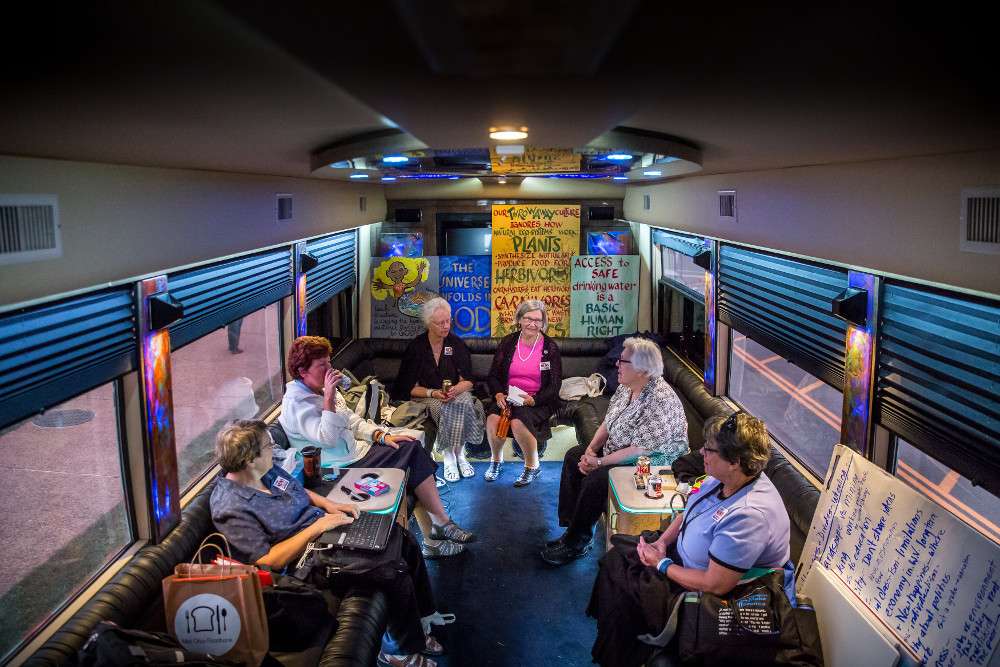
Sr. Simone Campbell (center, right), executive director of Network, sits with others on the Nuns on the Bus bus in Washington Sept. 22. Nuns on the Bus, a project of the national Catholic social lobby Network arrived in Washington the same day as Pope Francis. The effort brings Catholic sisters to face-to-face meetings with people across the country to better understand their concerns and needs. (CNS /Lisa Johnston, St. Louis Review)
Furthermore, in 2017 the commission to investigate the female diaconate continued its work. I believe their efforts will also continue through 2018, as they explore the history and role of deaconesses. I predict in a time when the Church is seeing more parishes staffed by women and Pope Francis is expressing his openness to the possibility of having certain married men serve as priests, that the Church knows it needs to elevate female leadership to the role of the diaconate.
However, questions remain, such as, what would a female diaconate look like? Would it be the same as the permanent diaconate for men? The Church is preparing for its next synod in 2018 on Young People, The Faith and Vocational Discernment, and though nothing has been said about married priests or the female diaconate, some suggests that there is language in the assembly’s preparatory document that could open up such dialogue, particularly the discussion on new frameworks for pastoral care.
As the Church enters another year facing a clergy shortage, with data showing that more Catholic women are administering the day-to-day life of parishes, 2018 presents an opportunity to elevate the role of women, both lay and religious, in the Church. (Note that some sources reference an uptick in the number of seminarians and reports of a 100 more men being ordained in 2016 than 2010, but persistent challenges to clergy growth and the maintaining of parishes still exists. See this and this.)
Regardless of any institutional resistance, the future of the Church is female.
Jeanine E. Kraybill is an assistant professor of political science at California State University, Bakersfield.





